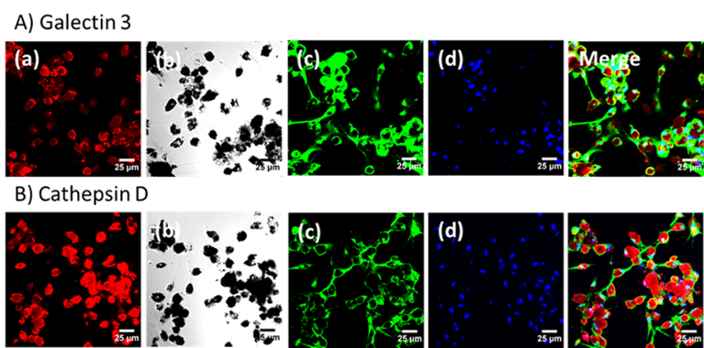
Confocal images of macrophages treated with GaNP. a) Fluorescein-conjugated GaNP (Red), b) macrophages and GaNP, c) galectin 3 (A) or cathepsin D (B), d) Nuclei (Blue). Nanoparticle-treated MDMs were incubated with primary rabbit galectin 3 or cathepsin D. These proteins were visualized by incubation with Alexa Fluor®488 goat-anti-rabbit antibody. The scale bar represents 25 μm.
The Narayanasamy Laboratory is working on Mycobacterium, HIV virus, MRSA, Pseudomonas aeruginosa and Acinetobacter baumannii. Over 4 billion people are infected by some kind of pathogens and are more likely to develop into active infection. Gram-negative bacteria have intrinsic abilities to develop new mechanisms of resistance and can pass along genetic materials that allow the next generation of bacteria to become drug-resistant as well. Thus, there is a critical need for new antibiotics and drug delivery techniques to meet the needs of patients now and in the future. Our lab is working on asymmetric synthesis of drug compounds, drug discovery against drug resistant pathogens targeting MEP pathway, menaquinone pathway and iron metabolism. The property of cyclic diphosphate is also studied thoroughly. In addition we also use nanoparticle technology to target drug resistant pathogens and co-infection in macrophage. In addition we also discovered that Ga nanoparticle could be used as a single drug to treat HIV-TB co-infection. We will be optimizing the Ga nanoparticle to determine best results by in vitro and in vivo. Ultimately, these data could lead to the discovery of new drugs or techniques to treat drug resistant infections, with the potential that other human pathogens could be susceptible as well. In addition we also work in neurons development. Methyl glyoxal, a toxic material generated by glycolysis in brain, affects the survival of neurons. To protect the neurons we enhance the glyoxalase pathway to detoxify the methyl glyoxal. We also design, synthesize and test novel compounds to enhance glyoxalase pathway for detoxification. The successful flavonol antioxidants from our preliminary studies in cerebellar neurons will be tested for reducing aging and Alzheimer’s disease in animal models.Welcome to the Narayanasamy Lab.

